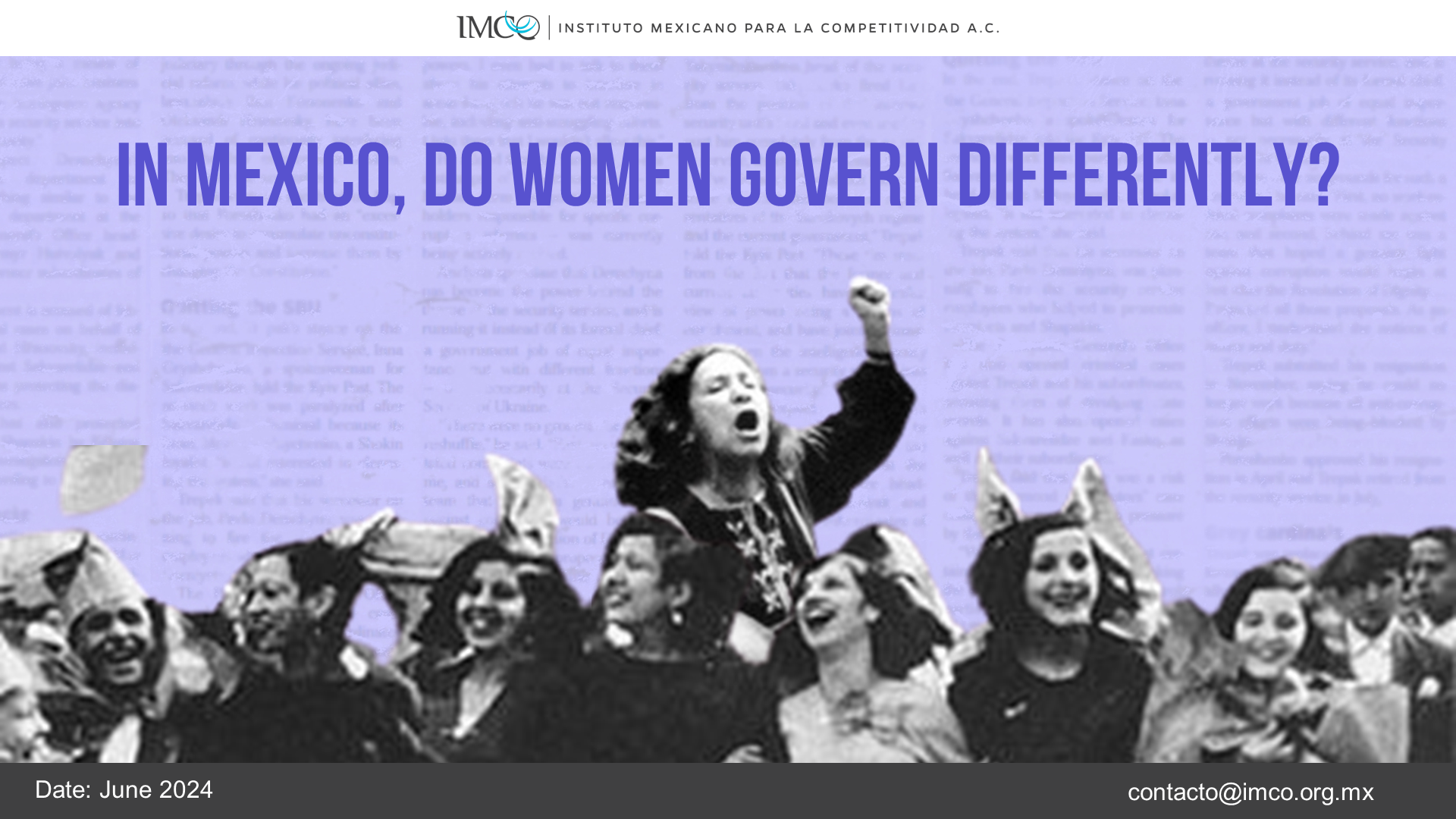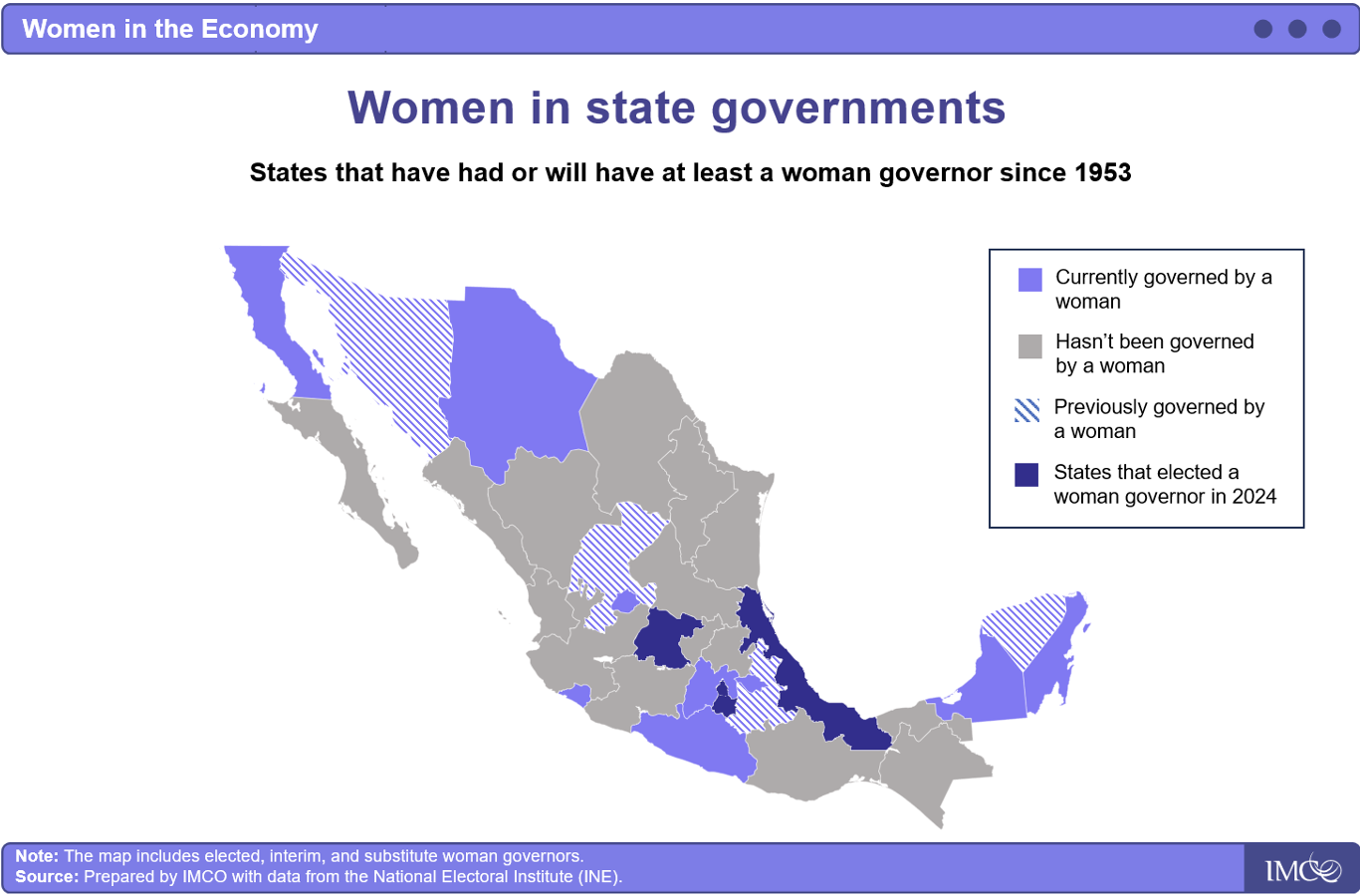
In Mexico, do women govern differently?
- Up to date, evidence suggests that a governor's gender does not determine the outcomes of their administration.
- The 2024 election results provide an opportunity to generate more evidence on the performance of men and women in state governments.
According to UN Women, worldwide, nine out of ten heads of state (or its equivalents) worldwide are men. Starting October 1, 2024, Mexico will join the nations led by a woman. In addition to the election of the country's first female president, four additional women have been elected to lead Mexico City, Guanajuato, Morelos, and Veracruz, resulting in a total of 13 female governors by the end of 2024.
According to studies by international organizations such as the Inter-American Development Bank, greater female representation is associated with more inclusive policies and higher social spending on education and health. In this context, the Mexican Institute for Competitiveness (IMCO) conducted a pioneering study to determine if there are differences in the outcomes between female and male state governors from a competitiveness perspective in Mexico.

IMCO analyzed 72 competitiveness indicators of the 32 states in the country between 2005 and 2022. A panel data structure segmented between years governed by men and by women was used. The main source of data was the National Institute of Statistics and Geography, and the study's methodology consisted of two parts:
- Analysis of density distributions by gender. From these, 10 variables with notable differences by gender were identified and subjected to descriptive statistics analysis (mean, median, standard deviation, and kurtosis).
- Principal component analysis that resulted in three interest groups: income, quality of life, and women in the economy, where statistical tests were conducted to determine if there is a significant difference by gender.
As a result of this study, it was observed that the difference between the means by gender is only significant for the group focusing on income variables, and the magnitude of the differences was not outstanding in any case. Although statistical variations were found between the governments of men and women, it cannot be concluded that gender is a causal factor in the results of state governments.
Some key takeaways by groups of interest:
- Income. Analyzes the states' capacity to generate income, considering variables like education, state income, and employed population. This is the only group where the differences are statistically significant, although their magnitude is not determinant. When women govern, differences are observed in:
- Higher education levels: On average, people have half a year more of education compared to governments led by men.
- Greater labor market participation: The proportion of people in the labor market reaches 43% compared to 41% when governments are led by men.
- Quality of life. Analyzes population well-being through indicators like the availability of medical personnel, citizen participation, and labor informality. During women's governments, it is observed (without statistical significance) that there is:
- More medical personnel: There are 3.3 doctors or nurses per thousand inhabitants compared to 2.8 in states governed by men.
- Lower informality: Informality is 53% while it is 57% in state governments led by men.
- Women in the economy. Examines the employment conditions of women, such as their economic participation and the gender pay gap. Some results in states led by women are (without statistical significance):
- Higher female labor participation: The proportion of women with a job or looking for one is slightly higher.
- Smaller gender pay gap: On average, for every 100 pesos a man earns, a woman earns 86 pesos when there is a female governor and 83 when there is a male governor.
The results of this study conclude that:
- So far, there is not enough evidence to indicate that women and men achieve different outcomes at the state level in Mexico when considering variables that measure competitiveness.
- If state government leadership is relevant, perhaps other factors, such as experience, education, and the sociopolitical context, could have a more significant impact than the gender of the governor alone.
- It is likely that the gender of the governor has limited predictive power in explaining variations in competitiveness indicators for the federative entities.
- Since the effects associated with leadership take time to materialize, it would be relevant to design complementary models to measure if there are gender differences in governance in the long term.
This initial study is a steppingstone for further analysis of the impact of women's political representation on their governing styles and their results. IMCO will continue to analyze how new leaders address gender inequality and seize opportunities to build a more inclusive country for the benefit of Mexico.
